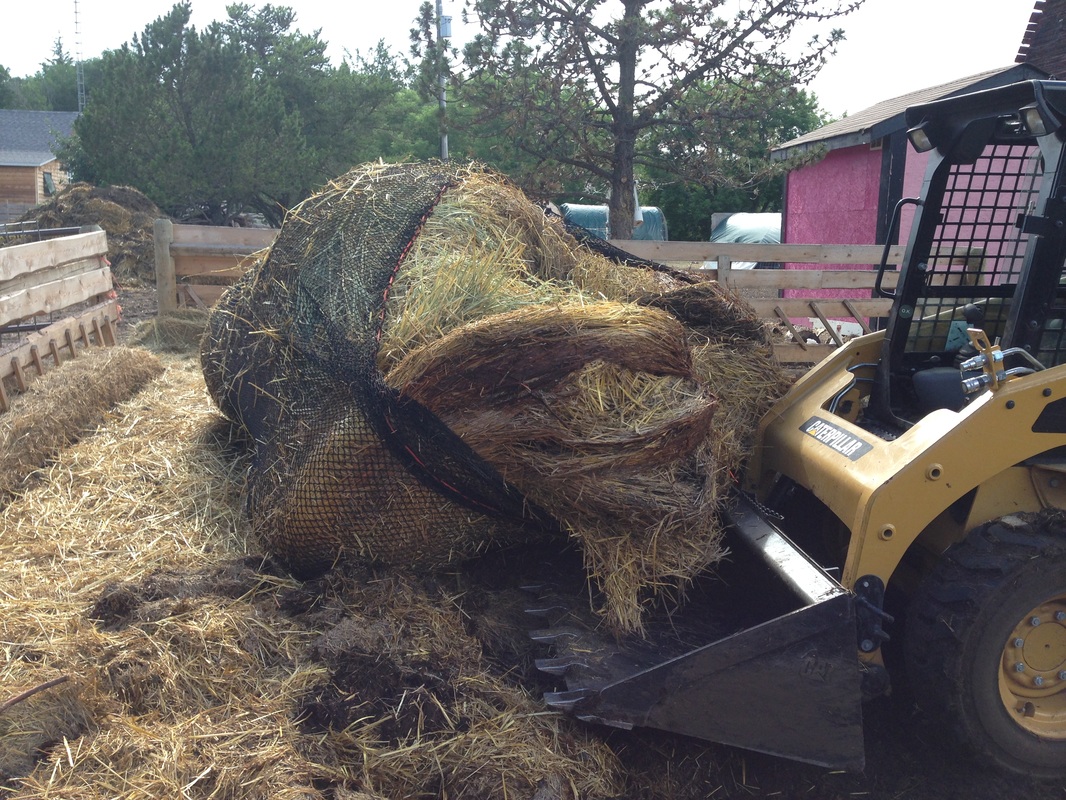That is the theory.
I put a bale of green feed in the net and gave one bale to the sheep, who never touched it, and one to the goats, who only pulled each straw out and ate the ones that had any green heads of grain and discarded the rest. They also climbed the bale like a mountain and pooped and peed on it, so then lost interest in the feed inside, which to them was soiled. The sheep had no interest.
The sheep do not eat green feed, except if they readily can get at the grain heads. I know now because I fed them some in their feeder and they did not eat it, just cleaned up the grain. At least the goats ate the stems and leaves if they were green, but not the yellow ones. So, I had two bales of feed to deal with.
The one in the goat pen had begun to compost on the bottom. It was sitting on top of 2 feet of hay, but that was not the problem. The goats had been climbing it and trampling it and soiling it, so they left it alone. Getting the net off the hay bale was not easy. The bottom was gross, smelly and very yukky. I had to get some help from the skid steer to lift it enough to get the net undone and started and then basically had to take the bale out a little at a time. For a first experience, it was terrible and did not fulfill any of the theory whatsoever.
The one in the sheep pen was almost the same, except it still was a whole bale, just rotting at the bottom. I opened it up and peeled the net down and the sheep have been picking through and eatiing the grain head. Now, I have to get the skid steer and the forks and lift the net out of that mess. It is also smelly, yukky and in a quagmire. Gross.
In all fairness though, sheep and goats do not eat green feed, so I have learned. So, I am going to try with hay. Today, since the goat pen was cleaned yesterday and the the feeders removed, I put hay in a small net designed to hold 2 square bales. I had to open the net and push the hay in by hand. It was not easy either, and it did not hold much that way, maybe 20 pounds, versus 100 pounds or so if it was filled with 2 whole hay bales. I may invest in the bales this winter just for the goats. Then I tied the top and set the bale in the goat pen. Immediately they jumped on it. No!
So I tied the opposite end so it was not a jumping site. The little ones may still climb it and jump on it. The other option is to rig up a way to hang it so it is free moving and vertical. That way they cannot climb on it and it will entertain them. It would be good to do that for winter in their barn. They were eating the hay from the net quite nicely.
Tomorrow I will retrieve the net from the sheep pen and put a whole round bale in it and see how the sheep do. There are enough sheep that for winter 2 nets would be used so that they can all feed at the same time. The goats would be fine with two square bales, which should last them 2 or 3 days if there is not waste, maybe longer. With no waste, my hay bill should be cut in half. Yes, in half. That would save about a thousand dollars a year, not quite enough to pay for the nets the first year, but after the second year, they would be paid for in full. I am still rooting for the theory.
Wish us luck .



 RSS Feed
RSS Feed